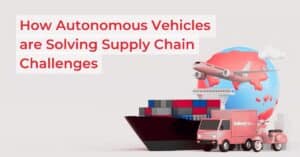Delivery robots on sidewalks from the US to Japan are showcasing the viability of autonomous vehicles to the masses. They are now the number one driverless vehicle use case in terms of deployed units, with commercial deployments active worldwide.
The COVID-19 pandemic fueled an increase in last-mile delivery services, but even looking ahead, growth is expected to continue. For example, in Tokyo, research by the World Economic Forum and McKinsey predicts e-commerce volumes will go up 85% percent by 2030, with a 71% percent increase in delivery vehicles. The global delivery robot market itself is expected to grow from $3.53 billion in 2020 to $30.05 billion by 2030.
Companies leading the market have taken different approaches to launch delivery robot services. Some start with extended pilots focused on developing autonomy and training AI models, using remote operators as a fallback. Others launch delivery services using 100% remotely operated robots. While all these companies operate driverless delivery robots and rely on teleoperation to a certain extent, they are very different in their go-to-market and their path to reaching their business goals.
Breaking new ground: the strategic imperative of proof
Technology-based startups operating in innovative new domains commonly face a dilemma: Do they go to market as soon as possible or do they first perfect their technology?
The more time they put into developing technology, the better it will be, and PRESUMABLY so will acceptance by customers. But it will also take longer to go to market, test the business model, and start capturing customers. In fact, it is around this very dilemma that the concepts of “Lean startup” and Minimum Viable Product were born.
In the automotive industry, as in other services that involve human safety, the minimum requirements are extremely high, requiring significant development resources to be invested before reaching the market for validation. Many startups would rather test their business model and gather customer feedback before making such an investment. However, if their robots or vehicles don’t have fail-proof autonomy, how can they start providing services?
The crux of the matter is identifying the element in the new service that needs to be proved or validated. Is it the autonomous technology that needs to be validated or is it maybe something else?
Sidewalk delivery robots – more than a question of autonomy
Sidewalk delivery robots are something completely new. They present a new approach to solving some of the issues around last-mile delivery including pollution and congestion. Their introduction presents an innovative service model and a new element in the public domain. Testing the service aspects of sidewalk delivery robots earlier rather than later can help identify and solve issues that may arise, prior to heavy investment in technology.
- Companies using teleoperation can demonstrate customer uptake, test pricing, and work out their revenue model, bypassing technology speedbumps.
- Drive social acceptance by the general public and regulators: while overall growth of deployments is steady, some cities, including San Francisco and New York, have previously instituted bans on delivery robots, citing issues such as sidewalk congestion. Some companies, like Coco and Kiwibot, are actively working with urban planning groups, to pre-empt objections and find solutions to the challenge of introducing robots to the public domain.
“What we’re doing now is working together in terms of regulation so that this happens in a coordinated way, not the way that electric scooter companies did it,” Kiwibot co-founder David Rodriguez told the Seattle Times recently.
Because remote operators can intervene and prevent accidents, teleoperation may help prove the safety of robots and their readiness for public spaces to regulators. Video and data collected by robots may even help cities identify and repair dangers and obstacles on streets and sidewalks.
How does teleoperation enable a minimum viable product for robots and autonomous vehicles?
Nearly all autonomous vehicle trials and commercial deployments rely on teleoperation to ensure mission accomplishment, due to regulatory requirements and developers’ own safety measures. Implementation models vary from remote supervision to full remote operation when needed. But some companies take it a step further and rely on teleoperation to create an autonomous vehicle MVP.
Early operational benefits: Breaking the driver-vehicle 1-to-1 ratio
- Robots are disrupting the delivery business in more ways than one. It is not only the vehicle form factor – but the way they use drivers. With the help of teleoperation, delivery robots create operational efficiencies even without autonomy, as it breaks the unity of driver and vehicle. A robot may have idle time due to how a fleet is distributed in the delivery area, but remote operators — the more expensive element in the operation — are utilized all the time. There’s no time when a moving robot does not have an operator, or “driver,” but it’s not necessarily a one-on-one relationship. A single operator may pilot any number of different robots during a shift, as efficiency and convenience demand.
Coco robot remote operator. Video source: Los Angeles times
- In addition, teleoperators can work from home, including those typically unable to participate in this transportation industry. The job no longer requires physically driving a vehicle or getting out and making a delivery. People with mobility issues now have access to new jobs, and operators have access to more potential employees.
- Companies can also gain efficiencies by utilizing workers during peaks. In the past, when you hired a driver who needed to drive from one place to another, you probably hired them for a full shift. Shorter teleoperation shifts are a win-win scenario for the service and the pilots. With no commute necessary, piloting a robot for two hours during lunchtime or evening spikes is worth their while.

Working smart on technology challenges
There is also an important technological-development case for teleoperation. Technology is constantly evolving, so better hardware and software for cheaper, easier development of AI is constantly hitting the market. Every year stronger processors are released so every year it becomes a little easier to develop this kind of AI. This is true for companies regardless of their approach — technology-first or business-first. But the latter group, who are addressing the business issues first, don’t waste resources when development is still hard, so they’re more efficient.
Delivery robots lead the way in proving commercial viability for driverless vehicles
When looking at commercial deployments of driverless vehicles, it is apparent that delivery robots are the leader in both the number of commercial operations and deployed units. Here are just a few examples:
- Starship has commercial operations in the USA, UK, Germany, Denmark, and Estonia and claims a fleet of 2,000 robots.
- Coco makes restaurant deliveries in Los Angeles, Austin, and Houston.
- Kiwibot operates on over 50 college campuses, and in the cities of San Jose, Santa Monica, Denver, and Dallas in the US, Taipei in Taiwan, and Medellin in Columbia.
- Teraki makes food deliveries for Domino’s Pizza in Berlin and Foodora in Stockholm.
- Other notable companies in this space include FedEx, Amazon,
In the process of coming up with a novel solution to last-mile delivery challenges, and with the help of teleoperation, delivery robot companies are also demonstrating a creative way to apply an MVP mindset in the transportation industry.






